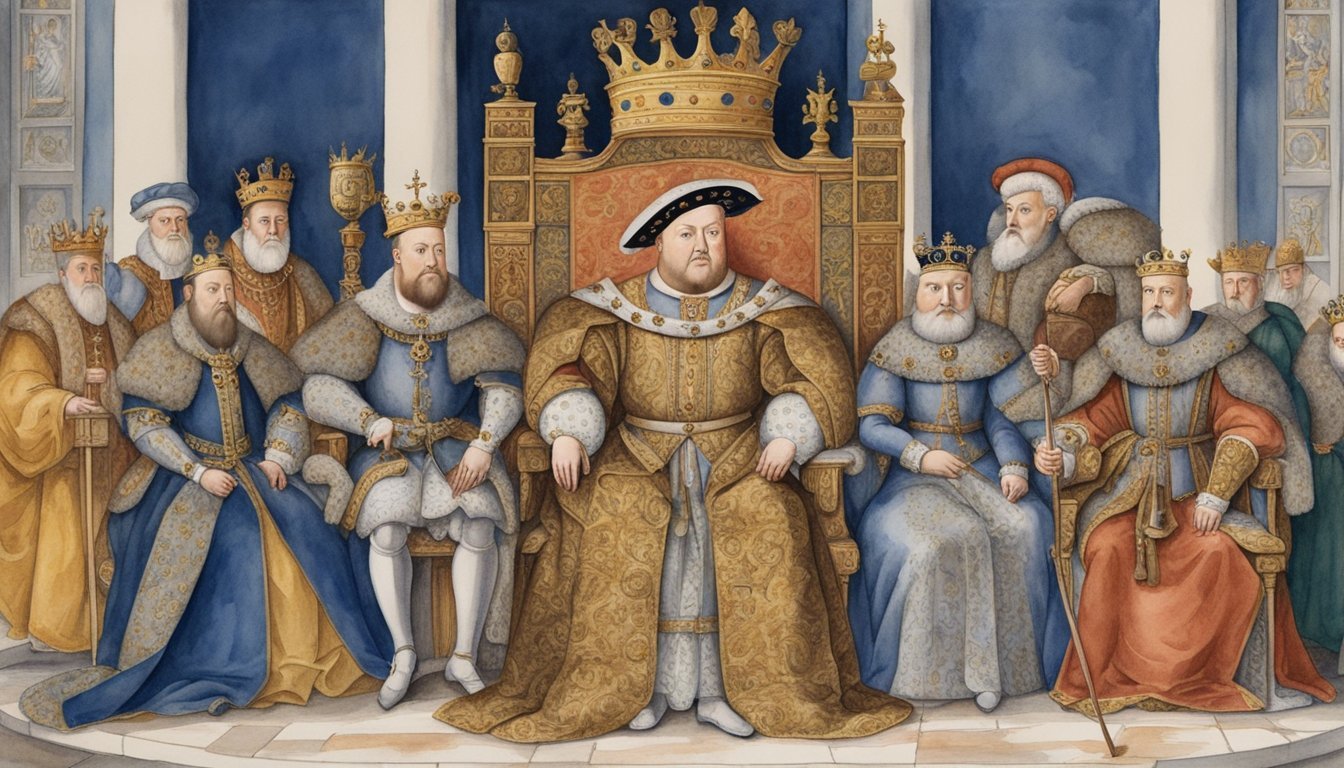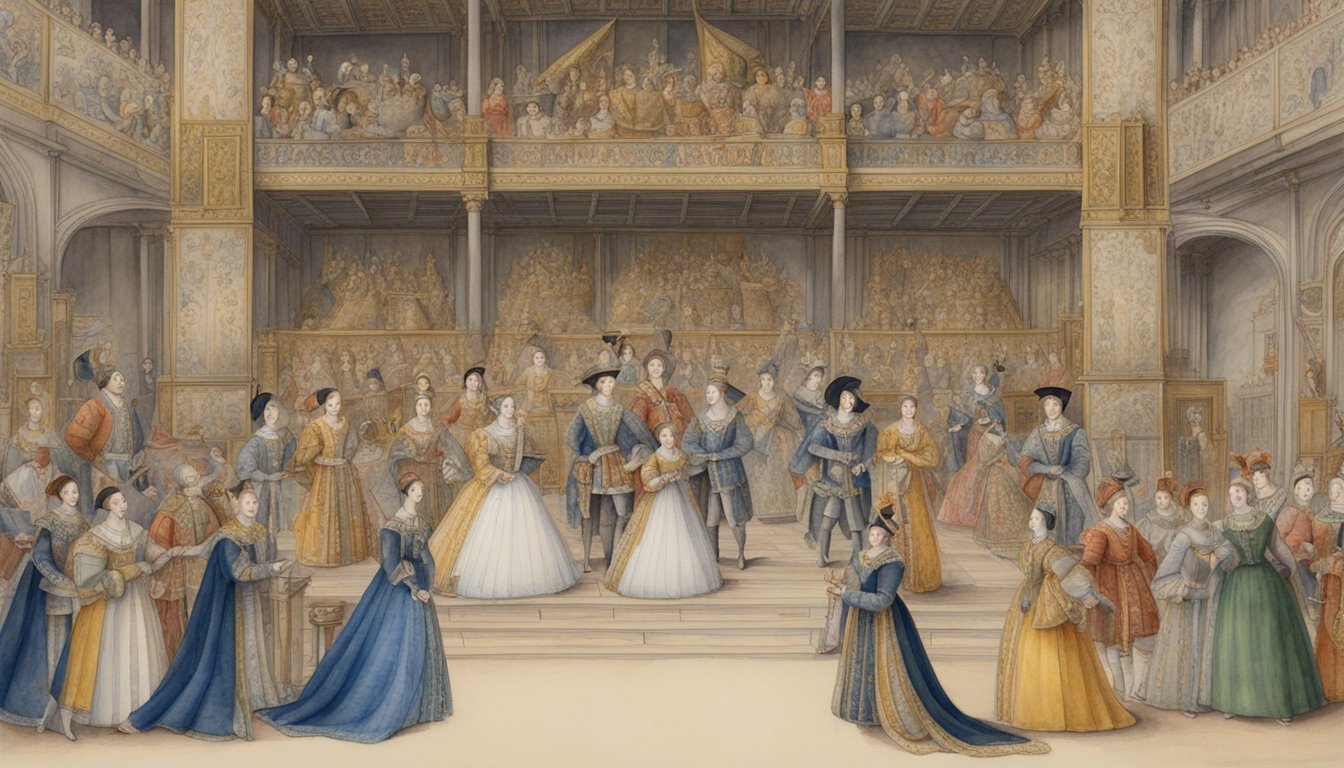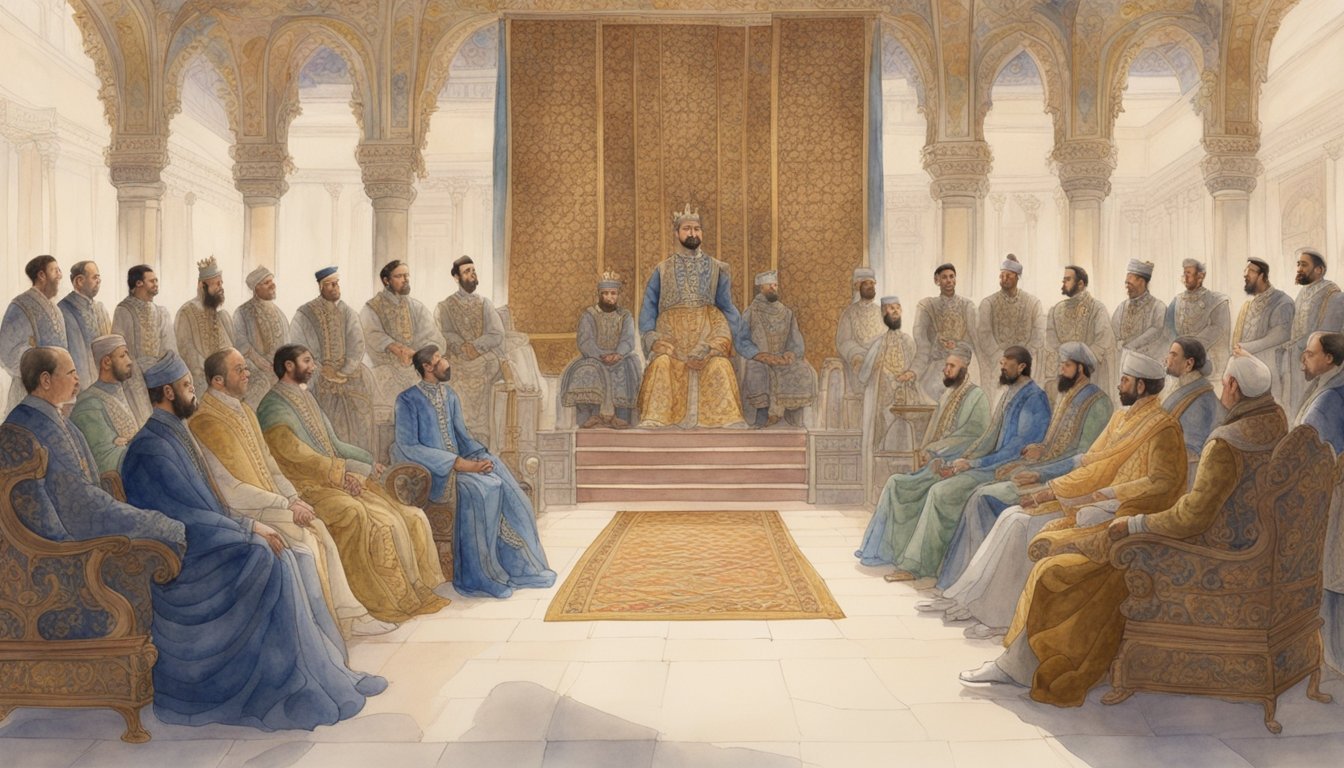Biography of King Henry VIII: The Life and Marriages of a Tudor Legend

King Henry VIII of England was one of the most infamous rulers in British history.
His reign from 1509 to 1547 was marked by dramatic changes in religion and governance, all driven by his restless ambition and personal desires. Henry is most famous for his six marriages and his role in creating the Church of England.

Born in 1491, Henry became king at just 17 years old.
He inherited a stable kingdom but sought to leave his own mark.
His quest for a male heir led him to marry six times, annuling marriages and even executing wives that failed to produce a son.
These actions not only altered the dynastic landscape but also caused significant religious turmoil, culminating in the English Reformation.
Henry was not just a ruler; he was a patron of the arts and an avid participant in courtly life.
His reign saw a flourishing of culture and the start of the English Renaissance.
Despite his many achievements, his later years were plagued by health problems and political conflicts, leaving behind a complex and controversial legacy.
Key Takeaways
- Henry VIII created the Church of England.
- He is well-known for his six marriages.
- His reign significantly impacted English culture and politics.
Early Life and Ascension to the Throne
Henry VIII was born into royalty, with a childhood marked by privilege.
His elder brother’s death made him the heir to the English throne, a position he would assume with significant impact.
Birth and Childhood
Henry VIII was born at Greenwich on June 28, 1491.
He was the second son of Henry VII and Elizabeth of York.
This royal lineage meant Henry spent his early years in the grand settings of the court.
His childhood was spent in the comfort of royal palaces.
He was groomed from an early age to understand his noble status.
This upbringing instilled in him a sense of confidence that would define his rule.
Education and Influences
As a child, Henry had access to the best education available.
His tutors were some of the most learned men in the kingdom, covering subjects such as languages, philosophy, and theology.
Henry showed great intelligence and was particularly skilled in languages, becoming fluent in Latin and French.
He was also deeply influenced by his surroundings.
Growing up in a court filled with political and cultural activity, Henry learned the importance of authority and power.
These early influences shaped his future decisions as a monarch.
Brother’s Death and Inheritance
In 1502, Henry’s older brother Prince Arthur died unexpectedly at the age of 15.
Arthur’s death left Henry as the next in line to the throne.
This sudden change thrust Henry into a new role as the Prince of Wales.
Henry’s inheritance set the stage for his future reign.
His waiting period until 1509, when he became king after the death of Henry VII, was one of preparation.
This transition marked the beginning of his journey towards becoming one of England’s most famous monarchs.
For those interested in secret spiritual knowledge, check out this link 📚.
Marriages and the Quest for a Male Heir
Henry VIII is famous for his six marriages, each driven by political and personal goals.
He sought a male heir to ensure the Tudor lineage and the stability of England.
Catherine of Aragon and the Struggle for an Heir
Catherine of Aragon was Henry’s first wife.
They married in 1509.
She was the daughter of King Ferdinand and Queen Isabella of Spain.
They had one surviving child, Mary I, but tragically, their male heirs died young.
Henry’s deep desire for a son led him to seek a divorce from Catherine.
This request was denied by Pope Clement VII, causing Henry to create the Church of England.
This bold move allowed him to annul his marriage and remarry.
Anne Boleyn’s Rise and Fall
Next, Henry married Anne Boleyn, a lady-in-waiting to Catherine.
Anne gave birth to Elizabeth I, who would become one of England’s greatest monarchs.
Yet again, no male heir was produced.
Due to her failure, political maneuvers, and accusations of treason, Anne was executed in 1536.
Anne’s influence on Henry and her role in the English Reformation are significant.
Her downfall highlighted the risks of royal intrigue and the desperation for a male heir.
Jane Seymour: The Mother of Edward VI
Jane Seymour became Henry’s third wife shortly after Anne’s execution.
Jane is remembered for giving birth to Henry’s only male heir, Edward VI.
Sadly, Jane died shortly after childbirth.
Henry cherished Jane and considered her his true wife.
Edward VI would go on to rule England, though his reign was short-lived due to his early death at age 15.
Later Marriages: Political Alliances and Personal Choices
Henry’s later marriages were for different reasons.
He married Anne of Cleves, a political alliance which ended in annulment after six months.
He then wed Catherine Howard, Anne Boleyn’s cousin, who was executed for adultery.
Finally, he married Catherine Parr, who outlived him and ensured his children’s legitimacy.
These later marriages showed Henry’s continued pursuit of both political stability and personal companionship.
Despite having six wives, his longing for multiple male heirs remained unfulfilled, leaving a lasting impact on England’s royal history.
For secret insights into spirituality and more, you might want to explore this link 😊.
Religious Reformation and the Church of England
King Henry VIII’s break from the Catholic Church led to the creation of the Church of England.
This move changed religious practices in England and had lasting effects on the country’s politics and society.
Break from the Catholic Church
Henry VIII sought to annul his marriage to Catherine of Aragon because she couldn’t produce a male heir.
He asked Pope Clement VII for an annulment, but the Pope refused.
Frustrated, Henry decided to reject the Pope’s authority.
By doing so, he pushed England into a new religious era.
Henry was excommunicated from the Catholic Church.
This step was pivotal in the English Reformation, a larger movement that swept through Europe.
His policy changes set the stage for England’s religious transformation.
Formation of the Church of England
In 1534, the Act of Supremacy was passed.
This act named Henry as the “Supreme Head” of the new Church of England.
This shift was not just about religion but also gave him more control over national affairs.
Henry appointed Archbishop Thomas Cranmer, who was key in pushing reforms.
He helped restructure church services and doctrines to align with Protestants.
The new church dissolved monasteries and took over church lands, increasing royal wealth.
Consequences of Reformation
The dissolution of the monasteries was a huge economic boost.
Lands once owned by the church were sold or redistributed, influencing the social structure.
The Church of England became the central religious authority, replacing the pope’s influence from Rome.
This move sparked resistance.
Catholics who remained loyal to the Pope faced persecution.
This led to a deepening divide between Protestants and Catholics in England.
Tensions and conflicts erupted, impacting England’s future politics and society.
For those interested in secret spiritual knowledge, explore this special link for more intriguing insights 🕵️.
Royal Policies and Administration
King Henry VIII’s reign saw several changes in domestic policies, foreign policies, and economic reforms.
His administration used influential figures like Thomas Wolsey and Thomas Cromwell to implement these changes.
These policies changed the face of England.
Domestic Policies
Henry VIII relied heavily on advisors like Thomas Wolsey and, later, Thomas Cromwell to run domestic affairs.
Wolsey, as Lord Chancellor, centralized power and streamlined the administration.
Cromwell took over after Wolsey’s fall and played a significant role in the dissolution of the monasteries.
This led to significant shifts in the power dynamics between the church and the state.
He also reformed the legal system by utilizing parliamentary power to legitimize his decisions.
One notable act was the establishment of the Royal Supremacy, which declared Henry as the Supreme Head of the Church of England.
This move reduced the papacy’s influence in England.
Foreign Policies
Henry VIII’s foreign policies were marked by his ambitions to assert England’s presence in Europe.
He engaged in several wars with France, aiming to reclaim territories lost during previous reigns.
He also formed alliances and rivalries with major European powers like Spain and the Holy Roman Empire.
The Royal Navy was significantly strengthened and expanded during his reign, making England a formidable naval power.
This expansion played a critical role in protecting England from potential invasions and supporting his territorial ambitions overseas.
Economic Reforms
Economic reforms under Henry VIII were partially driven by his need for funds for military campaigns and lavish court expenditures.
The dissolution of the monasteries was one of the most significant economic reforms, where church lands were confiscated and sold off, significantly boosting the royal treasury.
He also introduced new taxes and reformed old ones to fill the royal coffers.
These economic measures had mixed results; they brought in needed revenue but also led to social unrest and dissatisfaction among certain segments of society.
Henry’s reign marked a transformative period in England’s administration, demonstrating his prioritization of power consolidation and financial stability through strategic policy decisions.
👑🔍 For more secret spiritual knowledge, you can visit this link.
Cultural Influence and the Arts

Henry VIII’s reign greatly impacted the cultural landscape of England.
He was a pivotal figure in the English Renaissance, fostering advancements in art, music, and literature.
His royal court became a hub of cultural life, drawing in many great minds of the time.
Patronage of the Arts
Henry VIII was a notable patron of the arts.
He commissioned many works of art to glorify his reign and the Tudor dynasty.
The king’s interest in art led to the flourishing of a distinctive English art style, blending Gothic and Renaissance elements.
His support extended to prominent artists, including Hans Holbein the Younger, who painted some of the most famous portraits of Henry and his court.
Henry’s appreciation for visual arts was part of a broader trend in Renaissance Europe.
This period saw the revival of classical themes and techniques, and Henry ensured England was at the forefront.
His court became an artistic center that attracted talent from across Europe.
Advancement in Music and Literature
King Henry VIII was also a significant influence on music and literature.
He was quite the musician himself, composing pieces like “Pastime with Good Company.” His court was home to many skilled musicians and composers who thrived under his patronage.
This era marked a booming interest in different musical styles, laying the foundation for what we now call early English music.
When it came to literature, Henry’s reign saw the publication of numerous works.
Sir Thomas More, one of Henry’s close advisers, wrote “Utopia,” a book that has continued to resonate through the centuries.
This work explored ideas of social and political reform, reflecting the complex intellectual atmosphere of the time.
Royal Court and Cultural Life
The royal court under Henry VIII was a vibrant cultural center.
It was filled with poets, musicians, and thinkers who contributed to the rich tapestry of English cultural life.
Court ceremonies and events often featured elaborate musical performances and theatrical displays, showcasing the talents of the court’s residents.
One key figure at court was Sir Thomas More.
He served as Henry’s counselor and was known for his intellect and wit.
His presence at court helped elevate its cultural and intellectual life.
The court became a place where new ideas were openly discussed and debated, paving the way for significant cultural and social shifts in England.
👑 Henry VIII’s influence on culture extended far beyond his own lifetime, setting the stage for future generations to explore and expand upon the arts and humanities.
Intrigued by royalty’s connection to secret spiritual knowledge? Click here to discover more.
Health Issues and Physical Decline
Henry VIII started his reign as a strong and athletic young man.
At nearly 18, he was tall, handsome, and known for his love of sports and physical activities like hunting and jousting. 🏇
In 1524, Henry suffered a serious jousting injury when a lance struck him above his right eye.
This incident caused severe migraines which stayed with him for life.
Years later, another jousting accident in 1536 left him unconscious and severely injured his leg.
This wound never fully healed and led to chronic pain.
By his mid-30s, Henry’s health started to decline.
He became obese, developing a waist measurement of 52 inches and a chest measurement of about 53 inches by the time of his death.
By then, he weighed around 178 kg.
His once active lifestyle was replaced by inactivity and overeating. 🍔
The king’s illnesses included kidney and liver failure, which contributed to his death in 1547 at age 55.
He also experienced chronic stomach problems and extreme pain in his legs, needing constant medical attention.
Henry’s mental health also suffered in his later years.
He dealt with depressive episodes and exhibited drastic personality changes, possibly due to his long list of health issues.
If you’re curious about more secret spiritual knowledge, you might find this link intriguing. 🌟
Conflict and War
King Henry VIII’s reign featured notable conflicts, shaping the course of England’s history.
This period included wars with France, complex relations with Spain and the Holy Roman Empire, and internal revolts like the Pilgrimage of Grace.
The French Wars
Henry VIII had multiple wars with France, driven by his ambition to extend English influence.
One significant conflict was the Battle of the Spurs in 1513, where Henry’s forces defeated the French cavalry.
He also captured the towns of Tournai and Thérouanne.
In 1544, he launched another campaign, capturing Boulogne.
Despite these victories, maintaining military efforts strained England’s finances.
Henry’s alliances, including with Charles V, the Holy Roman Emperor, were crucial in his French campaigns, though they often proved unstable.
Relations with Spain and the Holy Roman Empire
Henry’s relations with Spain and the Holy Roman Empire were complex.
His marriage to Catherine of Aragon linked England and Spain.
Catherine’s nephew, Charles V, played a key role in European politics as the Holy Roman Emperor.
When Henry sought to annul his marriage to Catherine, it caused tensions with Spain.
Charles V supported Catherine, opposing the annulment.
These strained relations impacted Henry’s broader strategic aims, with alliances shifting between conflict and cooperation.
Internal Rebellions
Internal revolts also marked Henry’s reign, like the Pilgrimage of Grace in 1536.
This large uprising in Northern England was a reaction to Henry’s break from the Catholic Church and the dissolution of the monasteries.
Led by Robert Aske, the rebellion saw thousands of discontented citizens.
They opposed Henry’s religious reforms and demanded the restoration of the monasteries.
While initially negotiating, Henry eventually suppressed the rebellion with military force.
This uprising highlighted the significant internal resistance to Henry’s policies.
For more enlightening content, check out Secret Spiritual Knowledge 🌟.
Henry’s Legacy and Succession
Henry VIII’s reign had a significant impact on England’s history, particularly in terms of religion and leadership.
His successors, Edward VI, Mary I, and Elizabeth I, each left their mark in unique ways.
Edward VI’s Brief Reign
Edward VI, Henry’s only legitimate son, succeeded him at the age of nine.
Due to his young age, the government was run by regents.
Edward’s reign was marked by the push towards Protestantism that his father had started.
He passed laws to further break away from the Roman Catholic Church.
Sadly, his reign was short; he died at just 15 years old.
This left the country in a rather unstable state, especially in terms of religious conflicts.
For more details on spiritual aspects, visit Secret Spiritual Knowledge 🔮.
Mary I and the Restoration of Catholicism
Mary I, Edward’s half-sister, took over the throne after his early death.
She was determined to return England to Roman Catholicism, reversing the Protestant reforms of her predecessors.
This effort led to the persecution of Protestants, earning her the nickname “Bloody Mary.”
Her reign was marked by religious turmoil and political instability.
Despite her harsh measures, she failed to restore Catholicism permanently.
She died in 1558 with no children, so the throne passed to her half-sister, Elizabeth.
Elizabeth I and Her Golden Age
Elizabeth I is perhaps the most famous of Henry’s children.
Her reign marked a period of relative stability and prosperity, often referred to as the “Golden Age.” Elizabeth skillfully navigated religious tensions by establishing a moderate Protestant Church of England.
Under Elizabeth’s rule, England experienced cultural flourishing, with notable figures like William Shakespeare emerging.
She strengthened England’s global position through adventures like the defeat of the Spanish Armada in 1588.
Her long reign solidified the Tudor legacy and made her one of the most celebrated monarchs in English history.
Through Edward VI’s brief reign, Mary I’s aggressive Catholic restoration, and Elizabeth I’s Golden Age, Henry VIII’s legacy was carried forward in complex and diverse ways.
His children’s reigns painted a vibrant and tumultuous picture of this pivotal period in English history.
Political and Court Life

King Henry VIII’s court was bustling with political intrigue and powerful figures.
Thomas Wolsey, a brilliant statesman, held significant influence as a Cardinal.
He served as Henry’s chief minister for many years. 🏰
Wolsey’s downfall came when he failed to secure an annulment for Henry’s marriage to Catherine of Aragon.
This led to the rise of Thomas Cromwell, who was a key architect in the English Reformation.
Thomas More also played a significant role at court.
He was appointed Lord Chancellor after Wolsey’s fall, contributing to government but later executed for not supporting Henry’s religious changes.
Key Acts passed by Parliament included the Act of Supremacy (1534).
This declared Henry the Supreme Head of the Church of England, breaking away from papal authority.
This gave him control over religious and political matters. 📜
Henry’s Ministers were essential in implementing his policies and navigating the complex web of court life.
Cromwell, especially, was instrumental in the dissolution of monasteries, which increased royal revenues.
Intrigue, shifting allegiances, and the king’s desire for a male heir shaped the court’s dynamic.
Henry’s quest for power and control over both church and state drove many of these changes.
Henry’s Personal Life
King Henry VIII, a colorful figure, had a rich personal life packed with various interests, a striking personality, and numerous relationships.
Interests and Hobbies
Henry VIII was quite the sportsman.
He loved hunting 🏹 and spent a lot of time in the forests around Greenwich.
Aside from hunting, he also enjoyed jousting and played a fair amount of tennis.
These activities kept him entertained and physically active during his early years as king.
Henry’s love for music is notable.
He composed his own pieces and played several instruments.
His court often held musical performances, where he showed off his skills.
Watching these performances was a favorite pastime.
Henry also had a profound interest in fashion.
He wore luxurious clothes and took pride in his appearance.
His wardrobe was filled with richly decorated garments, often setting trends among English royalty.
Character and Personality
Henry was known for his charisma.
His presence was commanding, and he had a way of making people feel important.
This helped him immensely in court politics and gatherings.
He was also very self-assured.
Henry’s confidence sometimes came off as arrogance.
He believed strongly in his divine right to rule and often made decisions without second-guessing himself.
However, Henry’s temper was something to be wary of.
If displeased, his anger could be swift and brutal.
This made many around him walk on eggshells, never sure when his mood might change.
Relationships and Mistresses
Henry’s personal life was marked by many tumultuous relationships.
He famously married six times, seeking to secure a male heir.
His wives included Catherine of Aragon, Anne Boleyn, Jane Seymour, and others, often gaining and losing favor quickly.
Besides his wives, Henry had several mistresses.
One of the most notable was Bessie Blount, with whom he had a son, Henry FitzRoy.
His relationships with his mistresses were often as complicated as his marriages.
The dynamics of his relationships were influenced by his quest for power and desire for a strong line of succession.
These personal dramas significantly impacted his reign and the English court.
Looking for more insights on secret knowledge? 🌟 Explore here.






